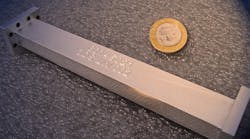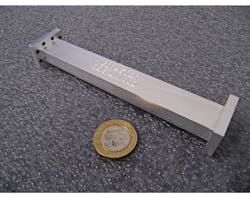Satellite communications (satcom) systems count on filters to keep signals in their proper channels. Because of the need for low passband insertion loss, the filters are typically metal waveguide types. For satcom applications, however, one challenge is designing and manufacturing waveguide filters that are light enough to launch on a satellite, especially within a high-density system that may require more than 600 filters.
As Airbus Defence and Space has discovered, 3D direct metal printing (DMP) of waveguide filters doesn’t just produce components with high performance. By using special aluminum alloys and additive manufacturing methods with a 3D printer, can about 50% of filter weight can be shaved off compared to traditional “subtractive” manufacturing methods.
Working with 3D Systems, Airbus Defence and Space built upon research funded by the European Space Agency (A0/1-6776/11/NL/GLC: Modelling and Design of Optimised Waveguide Components Utilising 3D Manufacturing Techniques) to develop the first 3D printed RF filter that has been tested and validated for use in commercial telecommunications satellites. The filter is essential to a high-capacity satellite such as the Eutelstat KA-SAT manufactured by Airbus Defence and Space, which integrates more than 500 RF filters.
The waveguide filter was printed with a 3D Systems ProX DMP 320 printer, using aluminum alloy in powdered form to create the metal parts. The direct printing process made it possible to integrate two components into one and achieve a 50% weight reduction, with faster production time and lower costs than traditional manufacturing methods.
The waveguide filter was designed with the aid of a 3D electromagnetic simulation software program, CST Microwave Studio. The availability of a 3D printer made it possible to fabricate a uniquely shaped depressed super-ellipsoidal cavity filter with balanced tradeoffs between quality factor (Q) and out-of-band rejection. “The main benefits of a monolithic design enabled by 3D printing are mass, cost, and time,” explained Paul Booth, an RF engineer for Airbus Defence and Space. “The mass is reduced because there is no longer the requirement to have fasteners.
“With direct metal printing there is also the no-cost bonus to have the outer profile more closely follow the inner profile, so only the really necessary metal needs to be used,” he continued. “The cost/time benefit comes from the reduction in assembly and post-processing.”


